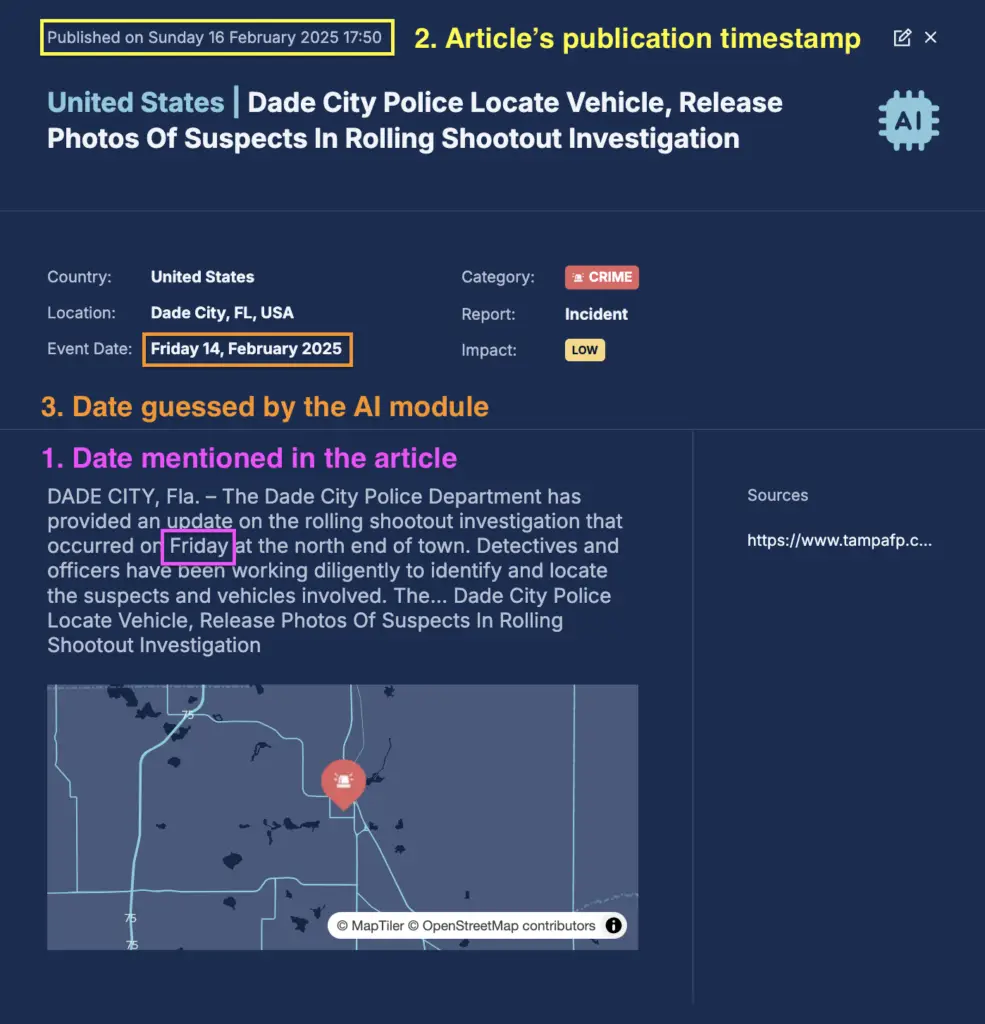In the ever-evolving landscape of risk intelligence, timely and accurate information is crucial for effective decision-making. At Hozint, we continuously refine our AI-driven capabilities to ensure our users receive precise and actionable intelligence. With this in mind, we are excited to introduce a groundbreaking new feature in Hozint AI: automated event date and time detection.
What is the New Date and Time Detection Module?
Our latest AI module is designed to extract and interpret temporal references within news articles and reports. By analyzing mentions of specific days, dates, and time frames within the text (1), the system intelligently determines when an event actually occurred or is scheduled to take place. To enhance accuracy, it cross-references these mentions with the publication timestamp of the article (2), allowing it to infer the correct event date (3).

This feature ensures that even if a report is published days after an event, Hozint AI can still accurately timestamp the event based on contextual references. Furthermore, it enables the identification of upcoming events at scale, providing users with enhanced foresight into potential disruptions.
Key Benefits
1. Improved Real-Time Event Accuracy: Traditional event detection systems often rely solely on the article’s publication date, which can lead to inaccuracies when reporting past or future events. Our new module mitigates this issue by ensuring that events are recorded with the correct occurrence date, improving the reliability of real-time alerts.
2. Enhanced Predictive Intelligence: By identifying scheduled events before they occur, Hozint AI empowers organizations to anticipate and prepare for potential disruptions. This is particularly beneficial for security analysts, business continuity teams, and crisis management professionals who need to plan ahead.
3. Automated Large-Scale Event Processing: Manually verifying event timestamps is a time-consuming task. With this automated feature, our AI can efficiently process vast amounts of information and accurately categorize events based on when they actually happen or are expected to occur, streamlining intelligence workflows.
4. Context-Aware Intelligence Gathering: By analyzing textual clues within an article, such as “yesterday,” “last Monday,” or “next Friday,” Hozint AI understands temporal nuances that standard keyword-based approaches may overlook. This contextual awareness significantly enhances the depth and accuracy of event intelligence.
Use Cases
1. Crisis Monitoring and Response: Security teams can use this feature to track the exact timing of incidents such as protests, violent attacks, or cyber threats, ensuring a swift and appropriate response.
2. Travel Risk Assessment: Organizations with global operations can proactively assess risks by identifying upcoming disruptions such as strikes, natural disasters, or geopolitical tensions, helping them adjust travel plans accordingly.
3. Corporate Security and Business Continuity: Businesses can leverage this capability to monitor planned threats or disruptions, such as industrial actions or political unrest, that may affect their supply chains and operations.
4. Government and Defense Intelligence: Intelligence agencies can benefit from improved event accuracy when analyzing military movements, planned exercises, or geopolitical developments that have strategic implications.
Hozint AI’s new date and time detection module marks a significant advancement in the accuracy and efficiency of event intelligence. By leveraging AI-driven contextual analysis, we provide our users with a more precise and reliable understanding of when events occur, empowering them to make informed, proactive decisions.
This feature is now fully integrated into Hozint AI, reinforcing our commitment to delivering cutting-edge risk intelligence solutions. If you’d like to see this capability in action, contact us today for a demo!

